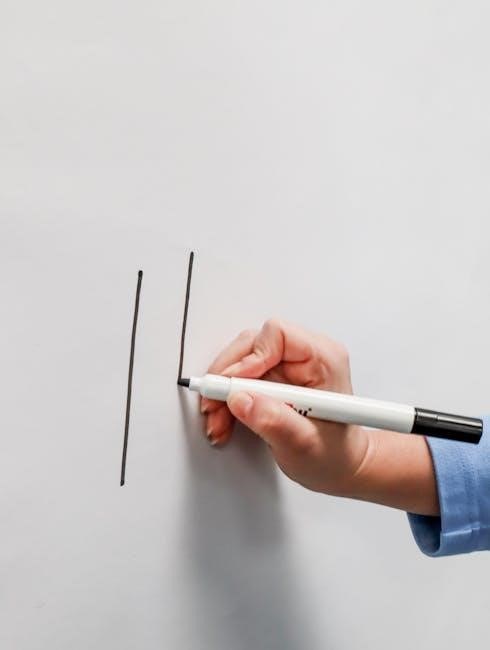Overview of American Hunter Feeders
American Hunter feeders are innovative, durable, and portable systems designed for wildlife management and hunting. They offer programmable timers, solar power options, and easy setup for efficient feeding solutions.
American Hunter feeders are high-quality, innovative systems designed for wildlife enthusiasts and professional game managers. Known for their durability and portability, these feeders offer programmable timers, solar power options, and easy setup. Popular models like the Sunslinger and RD-PRO provide efficient feeding solutions. With a focus on supporting healthy wildlife, American Hunter feeders are trusted for their reliability and versatility, making them a top choice for hunting and wildlife management needs. Their systems cater to various feeding requirements, ensuring optimal performance in different environments.
1.2 Key Features and Benefits
American Hunter feeders feature programmable digital timers, adjustable spin plates for varying feed sizes, and durable construction. They offer solar and battery power options, ensuring reliable operation. The feeders are easy to assemble and install, with user-friendly interfaces for setting feeding times and amounts. Their portability and versatility make them ideal for both small and large-scale wildlife management. Additionally, optional accessories like metal varmint guards enhance security, while the Feed Level Estimator ensures efficient feed distribution, optimizing wildlife nutrition and attracting game effectively.
1;3 Popular Models (R-KIT, RD-KIT, AH-AADK, Sunslinger, RD-PRO, R-PRO)
Popular American Hunter feeder models include the R-KIT, RD-KIT, AH-AADK, Sunslinger, RD-PRO, and R-PRO. These models offer varying capacities and features, such as digital timers, adjustable spin plates, and solar power compatibility. The Sunslinger is known for its versatility, while the RD-PRO and R-PRO models provide advanced feeding options. Each model is designed for durability and ease of use, catering to different wildlife management needs, from small-scale to professional hunting setups.

Setup and Installation
Setup involves easy assembly without tools, using mounting brackets and self-tapping screws. The digital timer is user-friendly, and the feeder is ready for operation quickly and efficiently.
2.1 Initial Assembly and Preparation
Begin by unpacking and inventorying all components. Locate the pre-pressed hex nuts under the feeder’s bottom half. Align and secure the hopper using the provided screws. Attach the spin plate and ensure it is level. Install the battery, making sure it is properly connected. Follow the manufacturer’s guidelines for initial setup to avoid damage. Double-check all connections before proceeding to programming or mounting.
2.2 Mounting and Placement Guidelines
Mount the feeder using the provided brackets and self-tapping screws. Place it in an open area, ideally 30-40 feet from trees to minimize varmint access. Ensure the feeder is at least 5 feet off the ground to protect against small animals. Position it on level ground for even feed distribution. Avoid low-lying areas prone to water pooling. Secure the feeder firmly to prevent tipping. Follow local regulations and consider wildlife patterns when choosing the location.
2.3 Connecting Power Sources (Battery and Solar Options)
Install a 6V battery (not included) by connecting the red and black wires to the respective terminals. For solar power, attach the American Hunter Solar Power Panel to the feeder, ensuring it faces sunlight. When using the solar panel, remove the internal battery to prevent damage. Connect the solar panel’s wires to the motor’s two-way plug. Ensure all connections are secure and follow safety guidelines to avoid electrical issues. This setup provides reliable power for consistent feeding operations. Proper installation ensures optimal performance and longevity of the feeder system.

Programming the Timer
Program the timer to set feed times and amounts using the digital interface. Use the Feed Level Estimator for accurate monitoring and efficient feeding schedules.
3.1 Understanding the Digital Timer Interface
The digital timer interface on American Hunter feeders is user-friendly, featuring a clear LCD display and intuitive buttons for navigation. The interface allows you to set specific feeding times, adjust feed amounts, and monitor battery levels. The timer includes a Feed Level Estimator to help calculate and track feed quantities accurately. By pressing the SET button, you can cycle through options like current time, feed times, and feed duration. This system ensures precise control over feeding schedules, making it easy to manage wildlife feeding efficiently.
3.2 Setting Feed Times and Amounts
To set feed times and amounts, use the digital timer’s navigation buttons to cycle through options. Press the SET button to select feeding times, then use UP/DOWN arrows to adjust. The Feed Level Estimator helps calculate feed quantity based on the amount entered. Set the desired feed duration and frequency, ensuring accurate dispensing. The interface allows multiple feeding schedules, providing flexibility for wildlife management. This feature ensures efficient feed distribution, tailored to specific needs and schedules.
3.3 Using the Feed Level Estimator
The Feed Level Estimator simplifies feed management by calculating the amount of feed based on the weight entered. Press the SET button until “SET FEED” appears, then input the feed quantity in pounds. This feature helps prevent overfeeding and ensures optimal feed distribution. It’s a key tool for maintaining efficient and controlled feeding schedules, making it easier to manage wildlife nutrition effectively while minimizing waste and saving costs over time.

Operating the Feeder
Operating the feeder involves activating it via the digital timer, adjusting the spin plate for feed size, and monitoring dispensing to ensure efficient and controlled feeding.
4.1 Activating the Feeder
Activating the feeder involves installing a 6V battery or connecting a solar panel, setting the current time, and programming feed schedules. Ensure the feeder is upright and stable before operation. Once powered, the digital timer will control feed dispersion based on programmed settings. For solar-powered models, allow the panel to charge fully before use. Always test the feeder with a small amount of feed to confirm proper function. Refer to the manual for specific activation steps and safety precautions.
4.2 Adjusting the Spin Plate for Different Feed Sizes
The spin plate on American Hunter feeders can be adjusted to accommodate varying feed sizes. Raise or lower the plate to ensure proper feed dispersion. For smaller feeds, lower the plate; for larger feeds, raise it. This adjustment ensures efficient feeding without waste. The metal spin plate is durable and designed to handle different feed types. Adjusting the plate correctly is crucial for optimal performance and to prevent clogging. Always test the feeder after adjusting to ensure smooth operation.
4.4 Monitoring and Controlling Feed Dispensing
Monitoring the feeder ensures proper feed dispersion and prevents waste. Use the digital timer to set specific feeding times and amounts. The feed level estimator helps track remaining feed. Regularly inspect the spin plate to ensure it’s clean and functioning correctly. Adjust settings as needed to maintain consistent feeding patterns. Check for blockages or clogs in the dispensing system. This ensures the feeder operates efficiently and effectively, providing consistent nutrition for wildlife.

Maintenance and Troubleshooting
Regular maintenance ensures optimal functionality. Clean the feeder, inspect for damage, and check battery connections. Address issues promptly to prevent clogs and ensure reliable operation.
5.1 Regular Cleaning and Inspection
Regular cleaning and inspection are essential for maintaining the performance and longevity of your American Hunter feeder. Clean the hopper, legs, and spin plate regularly to prevent mold and corrosion. Inspect the feeder for any damage, wear, or blockages. Check the battery connections and ensure all parts are securely fastened. Use gloves and a soft brush to remove debris. Regular maintenance helps prevent issues like clogged feed dispersion and ensures reliable operation. Always consult the manual for specific cleaning instructions.
5.2 Common Issues and Solutions
Common issues with American Hunter feeders include clogged feed dispersion, motor jams, and battery drain. Check the timer settings and ensure proper feed level calibration. Clean the feeder regularly to prevent mold and blockages. For motor issues, inspect the spin plate and ensure it’s clear of debris. Battery problems often result from loose connections or incorrect installation. Refer to the manual for troubleshooting steps. Regular maintenance and prompt issue resolution ensure optimal feeder performance and longevity.
5.3 Seasonal Preparation and Storage
For seasonal storage, clean the feeder thoroughly and disconnect the battery to prevent drain. Inspect for wear and tear, replacing any damaged parts. Store in a dry, protected area to avoid rust or damage. Before reusing, reassemble and test the feeder to ensure proper function. Proper preparation ensures longevity and reliable performance for future use. Always follow manufacturer guidelines for storage and maintenance to preserve your American Hunter feeder’s condition.

Accessories and Optional Equipment
Enhance your feeder’s functionality with Metal Varmint Guards for protection, Solar Power Panels for eco-friendly energy, and Additional Mounting Hardware for secure installation and versatility.
6.1 Metal Varmint Guard
The Metal Varmint Guard is a durable accessory designed to protect your feeder from damage caused by varmints and other small animals. Made from robust materials, it ensures your feeder remains intact and functional. Easy to install, it fits seamlessly with most American Hunter feeder models. This guard is especially useful in areas with high wildlife activity, helping to preserve feed and extend the life of your equipment. It’s a practical solution for safeguarding your investment.
6.2 Solar Power Panel
The Solar Power Panel is an optional accessory designed to provide a reliable and eco-friendly energy source for your American Hunter feeder. Compatible with most models, it charges the 6V battery, ensuring continuous operation. Easy to install, the panel is ideal for outdoor use, offering a cost-effective solution for wildlife feeding. For optimal performance, place it in a sunny location. Remember to remove the internal battery when using the solar panel to prevent damage. This accessory enhances the feeder’s efficiency and reduces maintenance needs.
6.3 Additional Mounting Hardware
Additional mounting hardware for American Hunter feeders includes brackets, adapters, and screws to ensure secure and customizable installation. These components provide flexibility for various setups, whether hanging or tripod-mounted. Durable and weather-resistant, they enhance stability and longevity. Use them to adapt your feeder to different environments and ensure proper alignment. Compatibility varies by model, so check specifications before use. Proper installation with these accessories ensures reliable operation and extends the feeder’s lifespan, making it a worthwhile investment for consistent wildlife feeding. Always follow manual guidelines for optimal results.

Safety Precautions
Always follow safety guidelines when handling batteries and electrical components. Avoid attracting excessive wildlife to prevent potential hazards. Ensure proper installation to maintain stability and functionality. Use caution when adjusting or cleaning the feeder to avoid accidents. Regular maintenance helps prevent malfunctions and ensures safe operation. Keep the feeder out of reach of children and pets to avoid unintended tampering or harm. Proper handling of the feeder and its components is essential to ensure the safety of both humans and wildlife. Never overload the feeder beyond its recommended capacity, as this can lead to structural instability and potential failure. Be aware of your surroundings when setting up or maintaining the feeder, especially in areas with high wildlife activity. Always disconnect the power source before performing any maintenance or repairs to avoid electrical shocks or injuries. Wear protective gear such as gloves and safety glasses when handling tools or performing tasks that may pose a risk. Keep the feeder and its components clean and free from debris to prevent attracting pests or creating fire hazards. Never use damaged or worn-out parts, as they can compromise the feeder’s safety and performance. Follow all local regulations and guidelines when placing and operating the feeder to ensure compliance and avoid legal issues. Always refer to the user manual for specific safety instructions and recommendations tailored to your particular feeder model. By adhering to these safety precautions, you can ensure a safe and effective feeding experience for both you and the wildlife.

7.1 General Safety Guidelines
Always follow the manufacturer’s instructions and safety guidelines when operating American Hunter feeders. Ensure proper installation and handling of electrical components to avoid hazards. Keep the feeder away from flammable materials and out of reach of children and pets. Regularly inspect the feeder for damage or wear and tear. Avoid overloading the feeder beyond its capacity to prevent structural issues. Be cautious when adjusting or cleaning the feeder to avoid accidents. Follow local regulations and guidelines for wildlife feeding. Wear protective gear when handling tools or performing maintenance tasks. Properly dispose of any waste or debris to maintain a safe environment. By adhering to these guidelines, you can ensure safe and effective operation of your American Hunter feeder.
7.2 Handling Batteries and Electrical Components
Handle batteries and electrical components with care to avoid damage or injury. Use a 6V or 12V battery, ensuring proper connections to avoid short circuits. When using a solar panel, remove the internal battery to prevent damage. Avoid mixing old and new batteries. Dispose of batteries responsibly, following environmental guidelines. Keep electrical components dry and clean to ensure proper function. Always follow the manufacturer’s instructions for wiring and connections. Regularly inspect wires and connectors for wear or damage. Consult the manual for specific voltage requirements and safety precautions.
7.3 Avoiding Wildlife Attraction Issues
To minimize unwanted wildlife attraction, position feeders away from high-traffic areas and sensitive habitats. Use varmint guards to deter pests like raccoons and rodents. Avoid overfilling, as excess feed can attract undesired species. Regularly clean up spilled feed and maintain a tidy surrounding area. Consider using feeders with adjustable spin plates to control dispersion rates, reducing waste. Follow local regulations and wildlife guidelines to ensure responsible feeding practices that benefit target species while minimizing ecological impact.

Warranty and Customer Support
American Hunter feeders come with a 1-year warranty. For support, contact their team via phone or email. Visit their website for manuals and troubleshooting guides.
8.1 Warranty Activation and Terms
American Hunter feeders are backed by a 1-year warranty covering defects in materials and workmanship. To activate, register your product on their official website within 30 days of purchase. The warranty extends to the original purchaser only and does not transfer. Proper installation and maintenance are required to maintain coverage. Using unauthorized parts or tampering with the system may void the warranty. For details, refer to the manual or contact customer support.
8.2 Contact Information for Support
For assistance with American Hunter feeders, contact their dedicated support team via phone at 1-800-XXX-XXXX or email at support@americanhunter.com. Visit their official website for live chat options, FAQs, and downloadable resources. Office hours are Monday-Friday, 8 AM to 5 PM CST. Ensure to have your product serial number ready for efficient service. Their team is committed to resolving inquiries promptly and effectively, providing comprehensive support for all feeder-related needs.
8.3 Online Resources and Manuals
Access comprehensive online resources and downloadable manuals for American Hunter feeders on their official website. Visit Support to find detailed instructions, troubleshooting guides, and FAQs. Manuals are available in PDF format for easy download, covering models like R-KIT, RD-KIT, and Sunslinger. Additionally, the website offers tutorials, warranty information, and contact details for further assistance, ensuring users can efficiently operate and maintain their feeders. These resources are designed to provide clear, step-by-step guidance for optimal performance.

Environmental Impact and Best Practices
American Hunter feeders promote sustainable wildlife management by providing controlled feeding. Always follow local regulations and practice responsible feeding to minimize environmental disruption and ensure ethical wildlife support.
9.1 Responsible Feeding Practices
Responsible feeding practices with American Hunter feeders involve proper placement, feed type, and quantity to avoid overfeeding wildlife. Place feeders in areas that minimize attracting non-target species and ensure easy cleanup. Use high-quality feed suitable for the wildlife you are managing. Avoid overfilling to prevent waste and mold growth. Adjust feeding schedules seasonally to match wildlife needs. Follow local regulations to avoid disrupting natural feeding patterns and maintain a balanced ecosystem. Regular maintenance ensures feeders operate efficiently and ethically.
9.2 Impact on Wildlife and Ecosystems
American Hunter feeders provide consistent nutrition, supporting wildlife health and outdoor experiences. They aid species during harsh conditions like winter, promoting antler growth and overall well-being. However, improper use can lead to over-reliance on feeders, potentially disrupting natural foraging behaviors. Overcrowding at feeding sites may stress habitats and increase disease transmission risks. Balanced use ensures benefits without harming ecosystems, maintaining biodiversity and ecological stability.
9.3 Legal Considerations and Regulations
Using American Hunter feeders requires compliance with local wildlife laws. Many states regulate feeding times and amounts to prevent overdependence and ecological imbalance. Ensure your feeder setup adheres to regional permits and guidelines. Additionally, check if specific feed types are restricted. Non-compliance may result in fines or penalties. Always consult local wildlife agencies before installing or operating a feeder to ensure legal and ethical practices.

Leave a Reply
You must be logged in to post a comment.